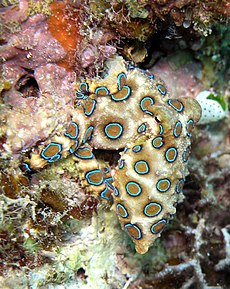This is an old revision of this page, as edited by 203.3.167.31 (talk) at 23:51, 7 September 2009 (→Venom). The present address (URL) is a permanent link to this revision, which may differ significantly from the current revision.
Revision as of 23:51, 7 September 2009 by 203.3.167.31 (talk) (→Venom)(diff) ← Previous revision | Latest revision (diff) | Newer revision → (diff)
| Blue-ringed octopuses | |
|---|---|

| |
| Greater Blue-ringed Octopus (Hapalochlaena lunulata) | |
| Scientific classification | |
| Kingdom: | Animalia |
| Phylum: | Mollusca |
| Class: | Cephalopoda |
| Order: | Octopoda |
| Family: | Octopodidae |
| Subfamily: | Octopodinae |
| Genus: | Hapalochlaena Robson, 1929 |
| Species | |
|
See text. | |
The blue-ringed octopuses (genus Hapalochlaena) are three (or perhaps four) octopus species that live in tide pools in the Pacific Ocean, from Japan to Australia. Despite their small size and relatively docile nature, they are currently recognized as one of the world's most venomous animals. They are recognized by their characteristic blue and black rings and yellowish skin.
Overview
There are three confirmed species of Hapalochlaena, and a fourth is still under research:
- Greater Blue-ringed Octopus (Hapalochlaena lunulata)
- Southern Blue-ringed Octopus or Lesser Blue-ringed Octopus (Hapalochlaena maculosa)
- Blue-lined Octopus (Hapalochlaena fasciata)
- ?Hapalochlaena nierstraszi - described in 1938 from a single specimen from the Bay of Bengal; the validity of this taxon has been questioned.
An individual blue-ringed octopus tends to use its dermal chromatophore cells to camouflage itself until provoked, at which point it quickly changes color, becoming bright yellow with blue rings or lines. It hunts small crabs, hermit crabs, and shrimp, and may bite attackers, including humans, if provoked or stepped on.
Venom

The blue-ringed octopus is the size of a golf ball, but its venom is powerful enough to kill humans. There is no blue-ringed octopus antivenin available.
The octopus produces venom that contains tetrodotoxin, 5-hydroxytryptamine, hyaluronidase, tyramine, histamine, tryptamine, octopamine, taurine, acetylcholine, and dopamine. The major neurotoxin component of blue-ringed octopus venom was originally known as maculotoxin but was later found to be identical to tetrodotoxin, a neurotoxin which is also found in pufferfish and cone snails. Tetrodotoxin blocks sodium channels, causing motor paralysis and sometimes respiratory arrest leading to cardiac arrest due to a lack of oxygen. The toxin is created by bacteria in the salivary glands of the octopus.
First aid treatment is pressure on the wound and rescue breathing. It is essential, if rescue breathing is required, that it be continued until the victim begins to breathe, which may be some hours. Hospital treatment involves respiratory assistance until the toxin is washed out of the body. The symptoms vary in severity, with children being the most at risk because of their small body size. The victim might be saved if artificial respiration starts before marked cyanosis and hypotension develop. Victims who live through the first 24 hours generally go on to make a complete recovery.
It is essential that immediate and full-time respiratory support be given (e.g., artificial respiration/rescue breathing) even if the victim appears not to be responding. Tetrodotoxin poisoning can result in the victim being fully aware of his surroundings but unable to breathe. Because of the paralysis that occurs they have no way of signalling for help or any way of indicating distress. Respiratory support, together with reassurance, until medical assistance arrives ensures that the victim will generally recover well.
The blue-ringed octopus is currently one of the most dangerous known sea creatures and, despite its small size, the blue-ringed octopus carries enough venom to kill 26 adult humans within minutes.
Feeding
Their diet typically consists of small crab and shrimp, but they may also feed on fish if they can catch them. They pounce on their prey, paralyze them with venom and use their beaks to tear off pieces. They then suck out the flesh from the crustacean's exoskeleton. In laboratory conditions they have been observed to engage in cannibalism, however this has not been recorded in the wild.
Mating
A male mates with a female by grabbing her mantle, which sometimes completely obscures the female's vision, then transferring sperm packets by inserting his hectocotylus into her mantle cavity over and over again. Mating continues until the female has had enough, and in at least one species the female has to remove the over-enthusiastic male by force. Males will attempt copulation with members of their own species regardless of sex or size, however interactions between males are most often shorter in duration and end with the mounting octopus withdrawing the hectocotylus without packet insertion or struggle.
Blue-ringed octopus females lay only one clutch of about fifty eggs in their lifetime towards the end of Autumn. Eggs are laid then incubated underneath the female's arms for approximately six months, and during this process she will not eat. After the eggs hatch, the female dies, and the new offspring will reach maturity and be able to mate by the next year.
References
- http://animal.discovery.com/convergence/oceans-deadliest/deadliest-creatures/deadliest-creatures_05.html
- Sheumack DD, Howden ME, Spence I, Quinn RJ (1978). "Maculotoxin: a neurotoxin from the venom glands of the octopus Hapalochlaena maculosa identified as tetrodotoxin". Science. 199 (4325): 188–9. doi:10.1126/science.619451. PMID 619451.
{{cite journal}}: CS1 maint: multiple names: authors list (link) - Caldwell, Roy, Dr. "What makes blue-rings so deadly?". Retrieved 2007-03-19.
{{cite web}}: Text "year 1996-2000" ignored (help)CS1 maint: multiple names: authors list (link) - Lippmann, John and Bugg, Stan, "DAN S.E. Asia-Pacific Diving First Aid Manual", J.L. Publications, Australia, May 2004. ISBN 0-646-23183-9
- "Dangers on the Barrier Reef". Retrieved 2006-12-06.
- Cheng, M.W. & R.L. Caldwell 2000. Sex identification and mating in the blue-ringed octopus, Hapalochlaena lunulata. Anim Behav. 60(1): 27-33.